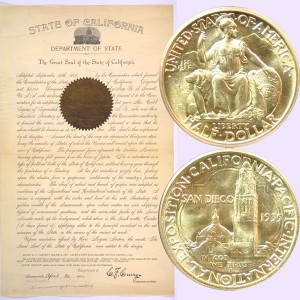Today, the California Pacific Commemorative Silver Half Dollar Coin with its image of Minerva and a bear remembers the admission of the area into the Union on September 9, 1850 and looks at some of the speculation about “Eureka” as a motto.
First, in his 1911 book, California Its History and Romance, John S. McGroarty provided a description of California’s efforts toward statehood and included a description of the new state’s seal and motto.
=====
There seems to have been little thought of organizing a Territory. The framing of a constitution proceeded rapidly and the completed document was signed on October 13, 1849.
Its most important pro vision was doubtless one which declared against slavery in the new state.
The boundary of the state as it exists today was fixed and the convention throughout was marked by harmony.
As soon as possible after the close of the convention, copies of the constitution were distributed through the state.
November 13 had been fixed as election day and a spirited campaign was waged.
The rainy season had begun and only a light vote was cast, but it was sufficient to ratify the constitution.
Peter H. Burnett was elected Governor and John McDougall, Lieutenant-Governor. Edward Gilbert and Geo. W. Wright were elected to Congress.
On December 15 the newly elected Legislature convened at San Jose, which became the new capital of the state.
The first important action of the new Legislature was the election of United States Senators, John C. Fremont and William M. Gwin being selected. The newly-elected senators and congressmen left at once for Washington to exercise their influence in securing admission of California to statehood.
It is needless to say that they were not welcomed, especially by those members of Congress from the south.
After four years of delay, during which time California’s claims had repeatedly been the subject of bitter discussion, statehood was finally granted on September 9, 1850.
Fremont drew the short senatorial term, which gave him only a few weeks in which to represent the state whose fortunes had been so closely linked with his own.
San Jose remained the capital of the state for two years, after which the seat of government was removed to Vallejo, where it remained until 1853.
For one year the capital was at Benecia, but in 1854 the seat of the state government was removed to the city of Sacramento, where it has remained until the present time.
In 1849 Major Robert Selden Garnett of the U. S. Army designed the great seal of the State of California.
An explanation of the design is officially entered in the records of the State of California as follows:
“Around the bend of the ring are represented thirty-one stars, being the number of states of which the Union will consist upon the admission of California.
“The foreground figure represents the Goddess Minerva, having sprung full-grown from the brain of Jupiter. She is introduced as a type of the political birth of the State of California, without having gone through the probation of a Territory.
“At her feet crouches a grizzly bear feeding upon the clusters from a grapevine, emblematic of the peculiar characteristics of the country.
“A miner is engaged with his rocker and bowl at his side, illustrating the golden wealth of the Sacramento, upon whose waters are seen shipping, typical of commercial greatness; and the snow-clad peaks of the Sierra Nevada make up the background, while above is the Greek motto ‘Eureka’ (I have found it), applying either to the principle involved in the admission of the state, or the success of the miner at work.”
Thus was completed the American conquest of California three hundred and eight years after the discovery of its golden shores by the immortal Portuguese mariner, Juan Rodriguez Cabrillo, who sailed in his Spanish galleon from Old Mexico in 1542, fifty years after the discovery of the New World by Christopher Columbus.
=====
In the Oregon Grower of March 1921, another author put forth a different idea on the state’s motto:
=====
When the pioneers in the forty nines came across over the trail from Pike’s Peak across the Rockies and came down over the Sierras, they glanced into the beautiful golden valleys of California, and I presume that perhaps they inspired the use of that Greek word which we find in the seal of California, “Eureka, Eureka,” meaning, I have found it. I have found it.
Truly they found a land of opportunity, not only gold in the soil, but gold on top.
=====
Another history book claims “Eureka” (I have found it.) applies to the discovery of gold in 1849 while a different source states the motto came from an old Spanish romance.
Whether it was gold, agriculture, romance, statehood or another reason entirely, the state’s motto “Eureka” can be seen on Minerva’s shield on the California Pacific Commemorative Silver Half Dollar Coin.
